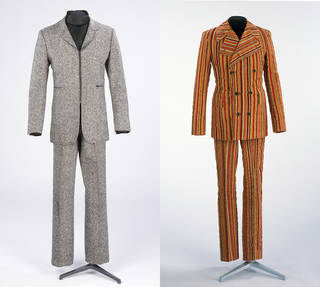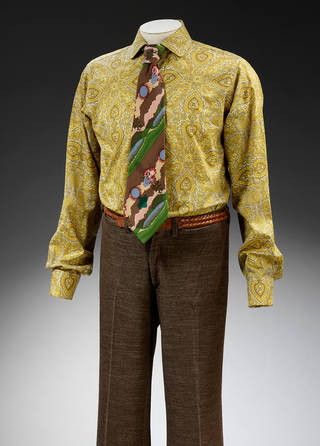The 1960s saw a huge shift in men's fashion, as the standard template of the tailored suit gave way to more flamboyant styles.
Before the 1960s, men's fashion was generally based on a conservative template that people didn't think to question: a shirt and tie; a plain, handmade suit; a jumper hand-knitted by a relative. Young men dressed much the same way as their fathers did. But in the late 1950s, the Mods (short for 'Modernists') signalled the birth of a confident new youth culture, demanding clothes that made a statement. In London, some people began wearing clothes heavily influenced by Continental style, specifically Italian slimline suits, with their 'bumfreezer' short jackets, and the beatnik looks of the Parisian Left Bank. Designer John Stephen opened his first boutique in Carnaby Street in 1957, selling cheap, sharp and colourful suits to men who became an important influence on London's street style.

As the 1960s gathered pace, the standard template for a man's suit began to accommodate subtly daring new elements: the collarless jacket (a look popularised by The Beatles in 1963, the year they launched their first album) and slim-fitting trousers, matched with heeled boots rather than shoes. Boutiques selling off-the-peg menswear spread across London, while traditional tailors and shirt-makers began to embrace society's increasingly informal new mood. Flamboyant elements such as embroidery and vividly printed shirts became acceptable parts of the everyday male dress code – in London at least.

By the mid-1960s, fashion-conscious young Londoners were challenging the staid rules of masculine etiquette that had persisted since Victorian times. Circulating in the overlapping worlds of fashion, music, the (newly influential) media and high society, a social group forged a bold new identity – the 'modern dandy', unashamed to wear frills, velvet and other elements previously judged to be too feminine for a man. A group of entrepreneurs capitalised on this shift in taste, setting up shops that married traditional tailoring techniques with the design flair of graduates from recently established Menswear courses.

Particularly influential men's fashion boutiques included Hung On You in the Kings Road, Blades in Dover Street and Granny Takes a Trip, also on the King's Road. Designer Michael Fish was a stylist in fashion and film (he was responsible for the vivid Liberty prints Terence Stamp wore in Modesty Blaise), before opening 'Mr Fish' on London's Clifford Street in 1966. Here he sold a range of 'peacock' styles that made no apology for being highly individual: wide ties, colourful suits and separates influenced by other cultures.

Later in the decade, military style also became popular – a trend accelerated by Mick Jagger, who wore a Victorian guardsman's jacket during a televised performance on Ready Steady Go! in 1966. At the end of the decade, violence in Vietnam and student uprisings in France signalled newly aware times, and consumerist enthusiasm for 'the next new thing' began to feel inappropriate. A growing interest in historic revival and various cultures encouraged British people to trawl second-hand shops looking for vintage clothes – particularly the fashions of the 1930s and 1940s and garments with connections to other parts of the world – to create looks through less consumerist means. As the 1970s approached, taking inspiration from the 1930s and 1940s, lapels and trousers took on exaggeratedly wide dimensions for both men and women, and the traditional distinctions between menswear and womenswear became blurred. Blue denim jeans, at first a counter-cultural garment, were widely worn and promoted by global brands. Clothing became increasingly unisex and informal.


